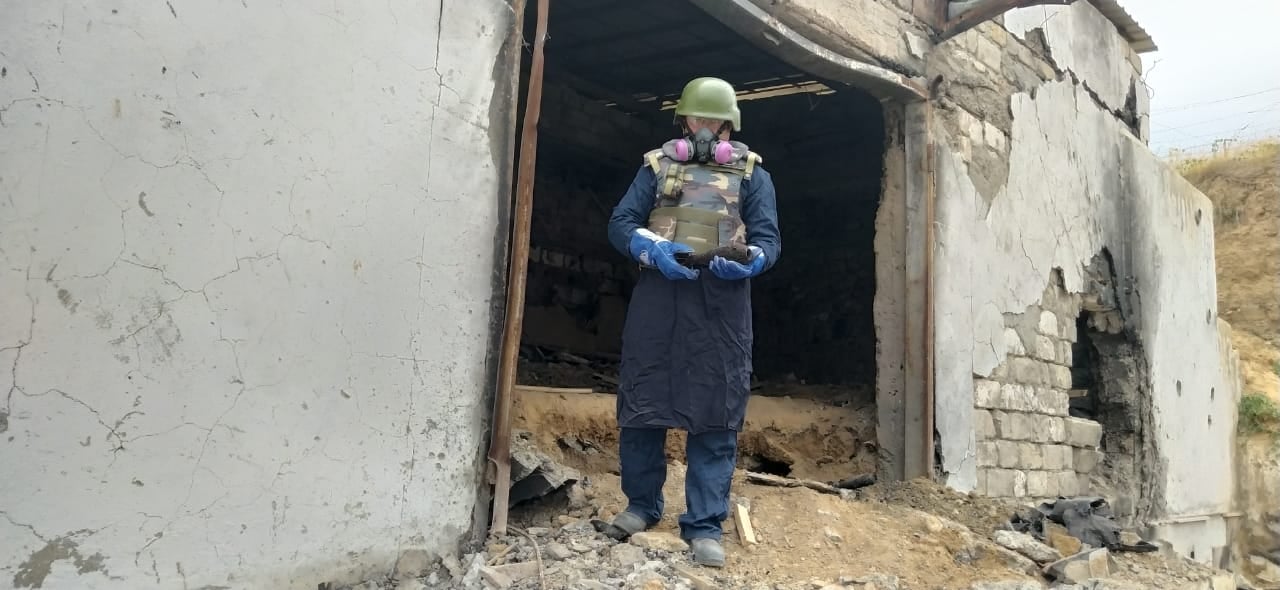Specialists of the Azerbaijan National Agency for Mine Action (ANAMA) have discovered white phosphorus munitions during the clearance operations in a former ammunition depot of Armenian forces located in Azerbaijan’s Jabrayil district that remained under Armenia’s occupation for nearly three decades since the early 1990s.
Seventeen 82-millimeter white phosphorus grenades of M47 type have been found in Jabrayil on July 3, according to ANAMA’s statement issued last week.
White phosphorus is a highly flammable incendiary material that flares with a yellow flame when fired from artillery shells, producing dense white smoke. It serves as a smokescreen for troop movements and to illuminate a battlefield. Human Rights Watch says the body’s absorption of the chemical can cause severe damage to internal organs, as well as death. This chemical substance could also lead to destructive effects on the environment and may remain within the deep soil for several years without any changes.
The Protocol III of the Convention on the Prohibition of Use of Certain Conventional Weapons defines white phosphorus as “any weapon or munition which is primarily designed to set fire to objects or to cause burn injury to persons through the action of flame, heat or combination thereof, produced by a chemical reaction of a substance delivered on the target.” The document prohibits using air-delivered incendiary weapons against military targets located among civilians and limits the use of incendiary weapons delivered by other means.
Armenia’s forces used prohibited white phosphorus bombs during the last year’s war with Azerbaijan. Last November, ANAMA specialists found two leftover artillery-delivered 120-millimeter white phosphorus ordnances of P-4 type in the Tartar city of Azerbaijan. Before attacking the Tartar district, Armenia’s armed forces launched white phosphorus projectiles on the non-combat areas in the Fuzuli district during the most intense days of the war.
Armenia also used white phosphorus munitions against Azerbaijan during the April War in 2016. Armenian forces have then fired phosphorus projectiles to Askipara village of the Tartar district.
Armenia and Azerbaijan have long been at odds over the latter’s Karabakh (Garabagh) region. On September 27, 2020, the decades-old conflict between the two countries spiraled after Armenia’s forces deployed in the occupied Azerbaijani lands shelled military positions and civilian settlements of Azerbaijan. During the counter-attack operations that lasted 44 days, Azerbaijani forces liberated over 300 settlements, including the cities of Jabrayil, Fuzuli, Zangilan, Gubadli, and Shusha, from nearly 30-year-long illegal Armenian occupation.
The war ended in a tripartite statement signed on November 10 by Armenia, Azerbaijan, and Russia. Under the statement, Armenia also returned the occupied Aghdam, Kalbajar, and Lachin districts to Azerbaijan.







 Iran's senior military leaders described the drone and missile attack on Israel on April 14 night as “successful".
Iran's senior military leaders described the drone and missile attack on Israel on April 14 night as “successful".
 The number of evacuees from flooded areas in Kazakhstan has reached 97,852 people, including about 32,856 children since March 27.
The number of evacuees from flooded areas in Kazakhstan has reached 97,852 people, including about 32,856 children since March 27.
 Azerbaijan officially unveiled the logo for the upcoming 29th session of the Conference of the Parties to the United Nations Framework Convention o...
Azerbaijan officially unveiled the logo for the upcoming 29th session of the Conference of the Parties to the United Nations Framework Convention o...



